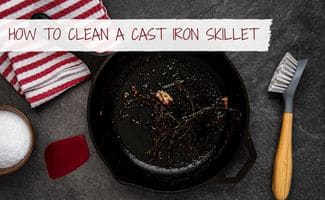Best Ways To Clean A Cast Iron Skillet: After Using, If It’s Rusty, Old, Burt On, & More
 Cast iron cookware! Is there anything it can’t do?
Cast iron cookware! Is there anything it can’t do?
From searing the perfect steak to serving delicious out-of-the-oven bread, this versatile product has certainly earned its stripes in the kitchen.
However, many people still believe that cast iron is difficult to clean and simply requires too much maintenance. Others don’t like the fact that it can rust, and some are concerned with its price tag.
What do you think?
Let’s explore these opinions, learn how to clean a cast iron skillet in various conditions, and understand how to keep this hardworking kitchen tool in tip-top shape for years to come.
Article Overview
- Cooking With Cast Iron
- Learn How To Clean A Cast Iron Skillet
- Cast Iron Skillet Restoration
- 7 Benefits Of Cooking With Cast Iron
Cooking With Cast Iron
Before we discuss how to clean your cast iron cookware, it’s worth noting why it has been a kitchen staple since its first use in 2nd Century China.
Cast iron is incredibly durable, and when cared for properly will probably outlive you. This does tend to make it more costly than conventional cookware, but it also means you will never have to replace it.
These sturdy products offer excellent heat retention which makes them suitable for baking cakes and bread, as well as stews and casserole dishes. When seasoned well, they also provide a non-stick cooking surface, which is a healthier option than today’s chemical coatings such as Teflon.
Family chefs can use cast iron cooking equipment on gas, electric, and induction stovetops. Alternatively, pop them in the oven to cook or bake, or use them as a Dutch oven.
Learn How To Clean A Cast Iron Skillet
It’s possible that cast iron cookware isn’t as popular as it should be because it doesn’t fit in with today’s modern lifestyle. Where almost everything is disposable or dishwasher safe, this product isn’t. Having said that, it doesn’t mean that you must dedicate your Saturday mornings to cleaning your pots and pans; you simply need to manage them a little differently.
Essential Skillet Cleaning Tools
Cast iron doesn’t demand any special cleaning equipment. In fact, you’ll need surprisingly few items to keep your cookware in peak condition. All you need is:
- A small amount of dishwasher soap
- A soft-bristled brush
- Cooking oil
- Coarse salt
- Paper towel
That’s it! Chances are, you have most of these items in your kitchen already. What comes next?
Cleaning Cast Iron After Use
The best way to clean a cast iron skillet is to do so as soon as possible after cooking. For the most effective results, follow these simple steps:
- Gently remove any food residue from the skillet with a paper towel or sponge.
- Rinse with warm water.
- Use your soft-bristled brush or a sponge with coarse salt to remove stubborn bits of food.
- Rinse again with hot water.
- Dry thoroughly with a soft towel.
- Apply a thin coat of vegetable oil to the entire surface of the pan and wipe down with a paper towel.
- Leave to dry in a warm oven, or store in a dry place.
Taking care of your cast iron skillet while it’s still warm makes it easier to clean. Harsh abrasives will impair the surface of your pan and remove the seasoning you’ve worked on for so long.
Additionally, soaking your pan in water makes it more susceptible to rust: one of the key reasons not to throw it in the dishwasher with the other pots and pans.
Seasoning Cast Iron Skillets
Cast iron, by nature, corrodes quickly. Therefore, an essential part of cleaning and maintenance of your cookware includes seasoning.
Seasoning is the process of polymerization which entails baking or bonding oils onto the iron at high heat, resulting in a shiny, non-stick cooking surface. This coating, or seasoning, also serves as a vital protective layer against rust.
Most fats and oils will do when seasoning your cast iron cookware. The ideal products, though, are oils with a high smoke point; those that can be used at high temperatures without burning such as safflower or grapeseed oil.
To season your cast iron skillet:
- Remove any moisture from the cast iron pan and then rub in the oil with a paper towel.
- Coat the bottom of the pan as well as the sides.
- Place the pan on the stove (medium-low heat) for at most an hour (or place it in your oven at 400 degrees for the same amount of time). The pan may smoke as it seasons, so turn on your vent hood to help prevent setting off your smoke detectors.
Seasoning your skillet regularly will help build up a dark hue that indicates a superior non-stick surface and a pan in excellent condition.
Cast Iron Skillet Restoration
After all this talk about being kind to your pots and pans, is it possible to restore a cast iron utensil once it has been damaged or neglected? Thankfully, yes!
If It’s Rusty
- Use a metal scouring pad (or steel wool) and some warm water to remove the rust
- Rinse in warm water and dry with a soft towel
- Cover the entire surface of the skillet with oil and rub in well
- Wipe down with a paper towel
- Place upside down in a warm oven for an hour
- Store in a cool, dry place
If It’s Burnt On
If you’ve burnt food onto the skillet, don’t be tempted to use cleaning agents that will rust the pan (water with soap, and anything acidic such as vinegar or lemon juice). In most cases hot water and a stiff-bristle brush will do the trick, but if that doesn’t work you can use baking soda. Baking soda acts as a mild abrasive that can aid in the removal of stubborn burnt on food, and its alkalinity helps neutralize odors or flavors that can be cooked into the pan.
- Remove as much food and debris from the pan as possible.
- Cover the bottom of the pan with baking soda.
- Add 2-3 tablespoons of water to the baking soda to create a paste (not enough to produce a liquid).
- Scrub the pan with a stiff-bristle brush or scouring pad.
- Rinse and repeat if necessary to remove any remaining burnt food. The more you scrub, the more of your good seasoning you will remove, so don’t go overboard.
- Fully dry the cast iron pan and then re-season it.
If It’s Cracked
If a pan is cracked, sadly, it’s reached the end of its life. Cast iron is strong, but not indestructible. Therefore, while it’s in one piece, it’s possible to restore with a touch of elbow grease and some TLC.
7 Benefits Of Cooking With Cast Iron
 Knowing the details of how to clean a cast iron skillet allows you to properly care for your investment. These durable, versatile cooking tools can last generations if properly maintained and will serve your family well.
Knowing the details of how to clean a cast iron skillet allows you to properly care for your investment. These durable, versatile cooking tools can last generations if properly maintained and will serve your family well.
Yes, cast iron cookware may be a little high-maintenance when compared with items that will happily go through the dishwasher. However, it more than makes up for this minor inconvenience by providing a versatile addition to your kitchen that will last a lifetime. And in today’s throw-away society, isn’t this a far greener option?
That’s only a couple benefits to cooking with cast iron. Learn several more in our benefits to cooking with cast iron skillet article.



